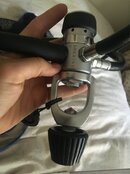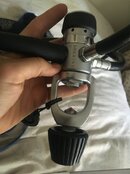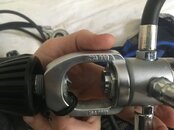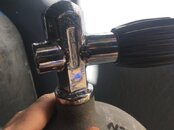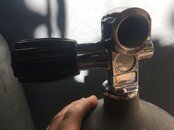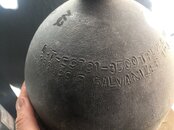kkmcwhat
Registered
Been diving steel 72's for about a year, and I like them, but rented an HP80 last weekend (I'm short, and the 72's either smack me in the head or in the legs), and it was awesome. I found a good deal on craigslist for one today, and brought it home, understanding that the valve was DIN, but thinking I could convert with an insert. Turns out it's a 300bar valve (I think; pictures below). My understanding is that an insert to convert to yoke isn't available for a 300bar DIN valve. First question: is this true?
Next questions: what are my options for using my yoke reg with this tank? (pics of tank and valve below too). I'm open to non-permanent adapters (as in, if I could still dive the 72s on a trip with my yoke reg, but there was a relatively easy adapter to use with 300bar DIN valve), or maybe preferably switching out the valve on the HP80 for a yoke valve. Somewhere I read that yoke valves don't go over 3000 psi - is this true? And if so... how did I dive one last weekend? I think I got in the water with 3400 on my pressure gauge; if that's the case, and I was using a yoke reg, there's gotta be a way to put a yoke valve on this tank, right?
Would love any help you guys could offer; I'd like to still dive all the tanks I have, and conversion to DIN in any kind of permanent sense isn't really something I'm interested in (all my diving is local, and I'm strictly interested in rec diving - no caves, no tech, not even really deep rec diving - so, DIN's not super interesting to me).
Any help is much appreciated!
Next questions: what are my options for using my yoke reg with this tank? (pics of tank and valve below too). I'm open to non-permanent adapters (as in, if I could still dive the 72s on a trip with my yoke reg, but there was a relatively easy adapter to use with 300bar DIN valve), or maybe preferably switching out the valve on the HP80 for a yoke valve. Somewhere I read that yoke valves don't go over 3000 psi - is this true? And if so... how did I dive one last weekend? I think I got in the water with 3400 on my pressure gauge; if that's the case, and I was using a yoke reg, there's gotta be a way to put a yoke valve on this tank, right?
Would love any help you guys could offer; I'd like to still dive all the tanks I have, and conversion to DIN in any kind of permanent sense isn't really something I'm interested in (all my diving is local, and I'm strictly interested in rec diving - no caves, no tech, not even really deep rec diving - so, DIN's not super interesting to me).
Any help is much appreciated!




